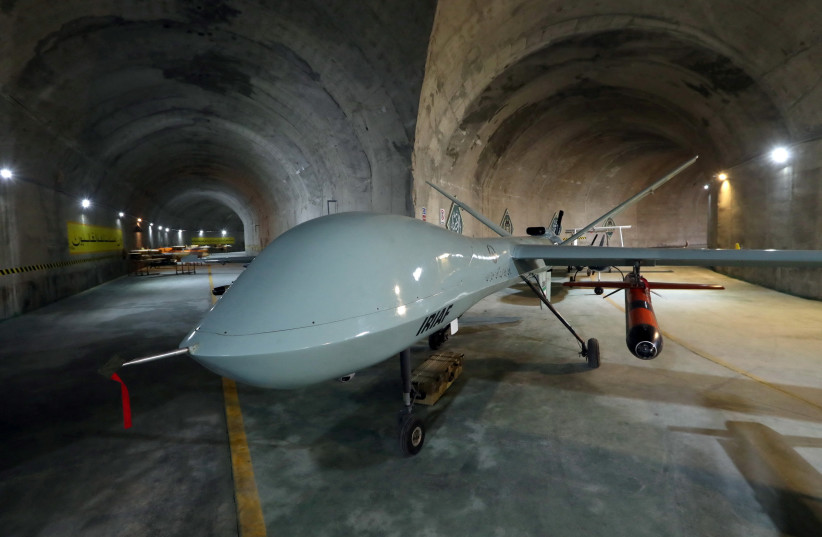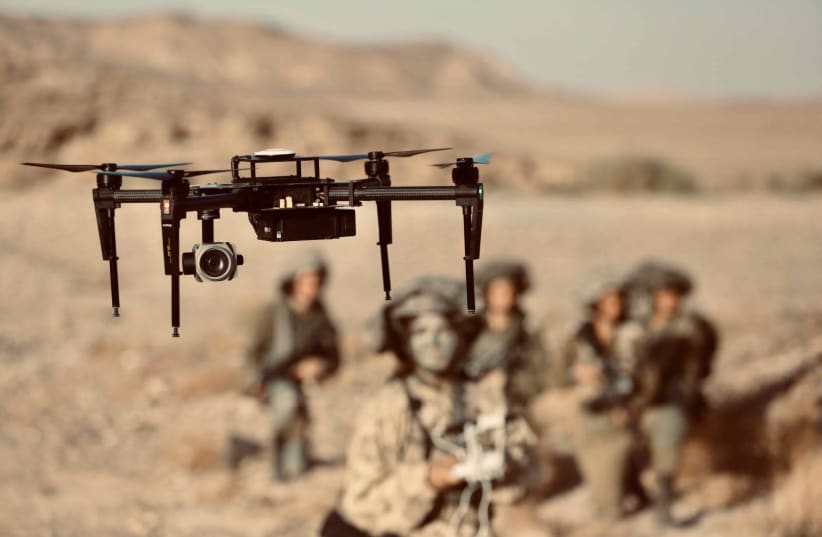Israel’s downing of three drones on Saturday illustrates the growing nexus of Iran-Hezbollah threats in the region – and specifically the Lebanese terrorist organization’s escalating attempts to target gas platforms off the coast of Israel.
Over the last several years, Iran has rapidly expanded its drone program and encouraged its proxies in the region to develop their own drone technology. These drones are often kamikaze ones, meaning they have a warhead and are designed to fly into their target. The drone threat against Israel has emerged slowly, in stages, over the last several years. Hezbollah has been using drones for many years, but they are increasingly more sophisticated and the threat is growing.
Back in 2014, the Center for the Study of the Drone at Bard College detailed some of the past history of these threats.
The article by Dan Gettinger and Arthur Holland Michel noted that “much of Hamas and Hezbollah’s unmanned technology derives from or originated in Iran, which has maintained an active military drone program since the Iran-Iraq War.”
It notes that back in 2004 an “Iranian-made drone operated by Hezbollah managed to fly in Israeli airspace for five minutes before it crashed into the Mediterranean sea. The 2.9 meter long UAV was not picked up on Israeli radars.


“The incident prompted the Knesset to convene a hearing with the IDF Chief of Staff Moshe Ya’alon.”
The report also noted that in “April 2005, a Misrad-1 UAV reportedly entered Israeli airspace, conducting an 18-mile (30 km.) reconnaissance flight over cities in the Galilee region.” During the 2006 war, Hezbollah launched more drones. These included a drone packed with explosives that targeted a ship. One of the drones even had 30 kg. of explosives, according to reports.
Drone capabilities in the Middle East
Hezbollah, Hamas and other Iranian backed groups have increased their drone threats in recent years. This included incidents in 2010, 2012 and 2014. The 2012 incident was particularly important because reports at the time said Tehran had attempted to spy on Israel’s Dimona facility using a drone.
The overall picture that emerges is that by 2018 Hezbollah and Iran – along with the Iranian-backed Houthis in Yemen, Iranian-backed militias in Syria and a large number of militias linked to Iran in Iraq – all had drone capabilities.
The UAVs shot down on Saturday appear to be of several different types. It is unclear if they carried explosives and how they were controlled. They do not appear to have been linked together to act as a kind of drone swarm.
In 2019 Iran used drones and cruise missiles to attack Saudi Arabia’s Abqaiq facility. It also operationalized Kataib Hezbollah in Iraq to target Saudi Arabia using drones.
Iran moved drone technology to the Houthis in Yemen who have launched numerous drone attacks against Saudi Arabia over the years. In January, the threat grew to include attacks on the UAE.
Hezbollah has about 2,000 UAVs
The Alma Research and Education Center said in December 2021 that, “in the special report we published on December 21, we stated that we estimate that today Hezbollah has approximately 2,000 Unmanned Aerial Vehicles (UAVs). Over the past 15 years, there has been a huge increase in the number of Hezbollah’s UAVs.”
Iran has increasingly used its militias in Iraq and Syria to target both the Kurdistan autonomous region in Iraq and US forces in Iraq and Syria using drones.
In October 2021, Iran also used drones in southern Syria to target the Tanf garrison where US forces are present. Last July, Iran used drones to target a commercial ship in the Gulf of Oman, killing two sailors on the bridge of the Mercer Street tanker.
This illustrates the growing and rapidly expanding regional threat of drones.
In February 2018, Iran lifted the veil on the drone threat by using a drone flown from T-4 base into Israeli airspace. It was shot down near Beit Shean. In August 2019 Iran sent Hezbollah “killer drone” operatives to a safe house in southern Syria to target Israel. Israel struck the operatives.
In March 2021, Israel used F-35s to down Iranian drone threats over Syria. Then Iran used a drone flown from Iraq in May 2021, which entered Israeli airspace near Beit Shean and was shot down.
Defense Minister Benny Gantz has warned of the growing threat. In September 2021 he noted that Iran was training drone operators at its Kashan base and mentioned “terror operatives from Yemen, Iraq, Syria and Lebanon [trained] in flying Iranian-made UAVs (unmanned aerial vehicles).”
Last November, Gantz revealed Iranian drone bases in Chabahar and on Qeshm Island. In February, Iran flew drones from Iran over Iraq to target Israel. They were shot down by the US-led coalition.
On February 17, Israel said it downed a drone flown by Hezbollah. The terrorist group claimed in February that one of its drones flew into Israeli airspace for half an hour. Israel activated Iron Dome and scrambled jets at the time.
In March, foreign reports, including by Al-Mayadeen, said Israel had destroyed hundreds of drones in Iran. On May 17 the IDF said it had downed another drone belonging to Hezbollah.
On June 9, Hezbollah leader Hassan Nasrallah threatened Israel’s gas platforms off the coast. “The immediate objective should be to prevent the enemy from extracting oil and gas from the Karish gas field,” Nasrallah said. Hezbollah wants to stop a potential maritime agreement, backed by the US, between Israel and Lebanon. Syria also blamed Israel for an airstrike on Saturday in Tartus.
Israel's efforts to combat the drone threat
The downing of the drone illustrates Israel’s abilities in detecting drones and also Israel’s investment over the years in technology to down them. These include the use of warplanes and Barak surface-to-air missiles, and equipping Israel’s latest corvette ships with the best systems to detect and stop drone and missile threats.
Israel has increased the abilities of Iron Dome to stop these types of threats as well. In addition, the Jewish state continues to carry out the campaign between the wars to prevent Iranian entrenchment in Syria. However, the overall context is that Iran is increasing the range of its drones, which are proliferating all over the region.
Last year it is believed that Iran moved Shahed 136 drones to Yemen. These may have a range that enables them to strike Eilat.
In addition, Tehran increased its investment in Iraqi-based militias such as Kataib Hezbollah to increase their drone and missile threats.
Israel is increasing its work with US Central Command and Navcent, as well as with new partners in the Gulf to discuss air defense priorities and drone threats.
The drone threat on July 2, therefore, is part of the much wider Iranian threat, and ties into the importance of Israel’s work with the US, UAE, Bahrain and other countries in the region to prevent destabilization.
The US is increasingly concerned about Iranian drone threats. Members of Congress have also worked on the Deterring Enemy Forces and Enabling National Defenses (DEFEND) Act and the Stop Iranian Drones Act. All of this is important in the context of Hezbollah’s recent escalation.
